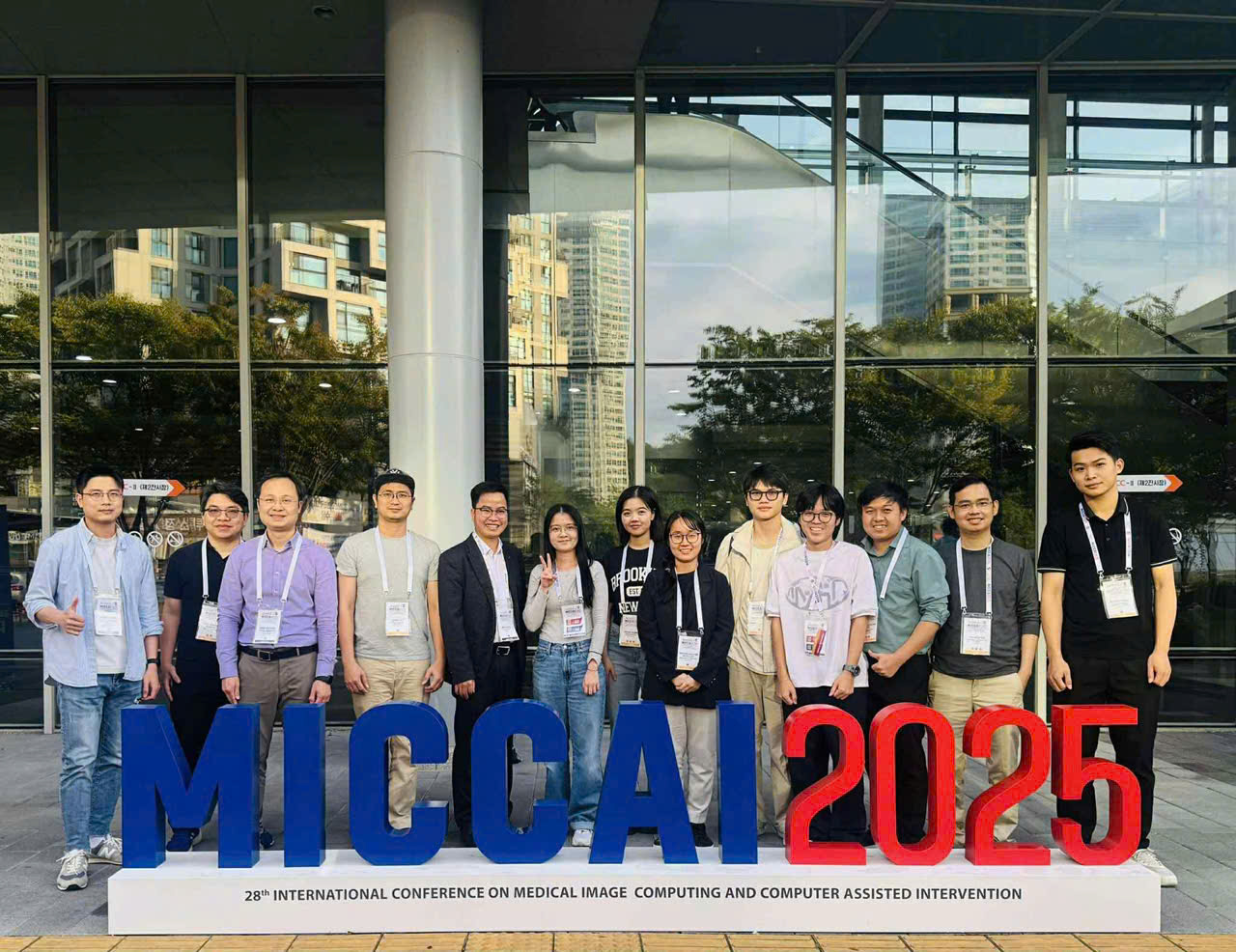This September, Phạm Hà Hiếu represented VISHC at MICCAI 2025, the 28th International Conference on Medical Image Computing and Computer Assisted Intervention. This is one of the world’s most prestigious medical AI conferences, where he presented his team’s new research on using artificial intelligence to improve the analysis of medical images.

Outside the Daejeon Convention Center, where VISHC’s research took its first steps onto the global MICCAI 2025 stage.
The paper, titled “Learning Disentangled Stain and Structural Representations for Semi-Supervised Histopathology Segmentation,” introduces a Color–Structure Dual-Student (CSDS) framework that enables AI models to separately learn color and structural cues in tissue images, improving segmentation accuracy under limited labeled data.
Research Team:
(Ha-Hieu Pham, PhD | Nguyen Lan Vi Vu | Thanh-Huy Nguyen | Min Xu | Ulas Bagci | Trung-Nghia Le | Huy-Hieu Pham, PhD) with institutional affiliations including VinUniversity, VNU-HCM, Carnegie Mellon University, and Northwestern University.
At MICCAI 2025 in Daejeon, South Korea, Hiếu presented the paper titled “Learning Disentangled Stain and Structural Representations for Semi-Supervised Histopathology Segmentation.” The work focuses on one of the most important steps in cancer diagnosis – identifying and segmenting glands in tissue images.
Hiếu explains:
“Our method tackles a very real challenge: how differences in staining protocols between hospitals and labs affect model performance. By separating color and structural learning, we make segmentation models more generalizable and reliable under limited annotations.”

Hà Hiếu (on the far right) with fellow researchers at MICCAI 2025.
This research introduces a new framework called Color–Structure Dual-Student (CSDS). Instead of treating the medical image as one whole input, the model separates it into two parts:
The two networks learn from each other through a “teacher” model, creating a more innovative way to learning from both labeled and unlabeled data.
What makes this approach special is not only its technical design, but its practical purpose. In many hospitals, especially in developing countries, data labeling is expensive and time-consuming.
By using a semi-supervised approach – where only a small part of the dataset is labeled – the model still achieves impressive accuracy. It also includes an uncertainty-aware mechanism, helping the AI understand which predictions it can trust.
“I was happy that many experts recognized how this work could help bridge the staining gap between different laboratories,” Hiếu shared. “That’s one of the biggest hurdles in bringing AI models into real medical use.”
Presenting in front of international researchers was both exciting and nerve-wracking for Hiếu. The preparation process took weeks: from designing the poster to rehearsing how to explain the research in clear and engaging ways.
“Attending MICCAI 2025 was truly an honor. I learned so much from leading researchers, discovered new ideas in medical AI, and built valuable international connections. It also motivates me to keep improving and hopefully submit another high-quality paper for MICCAI 2026,” he said.
At the conference, Hiếu received positive feedback from global professors who praised his team’s method for solving real-world problems in pathology. This is a key sign that VISHC’s research direction is on the right track.

Hà Hiếu standing by his poster at MICCAI 2025 – where months of late-night experiments and discussions finally meet the world.
After the conference, Hiếu started discussions for collaboration with Dr. Md Mostafijur Rahman from The University of Texas at Austin. Their goal is to explore Efficient AI – developing models that require fewer labels while still performing strongly on medical imaging tasks.
He and his VISHC teammates also plan to extend this research to other types of medical data, such as MRI or CT scans, to create broader applications in healthcare AI.

Hà Hiếu (right) and Dr. Md Mostafijur Rahman from The University of Texas at Austin – a new friendship that could spark future collaborations in medical AI.
Hiếu’s journey reflects the growing presence of Vietnamese researchers in the global AI community. His story is not just about one paper, but about how young scientists at VISHC are contributing to the world’s understanding of medical AI.
“It’s inspiring to see how research from Vietnam can make its way to top international stages,” Hiếu said. “I’m proud to be part of this journey with VISHC, and I hope our work continues to open doors for more young researchers.”

Hà Hiếu (fifth from the right) and the Vietnam research delegation at MICCAI 2025.